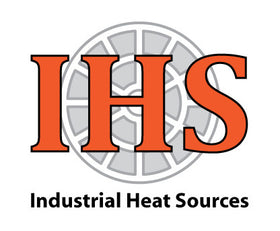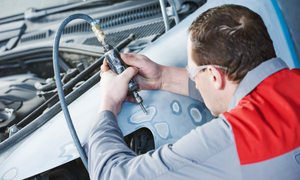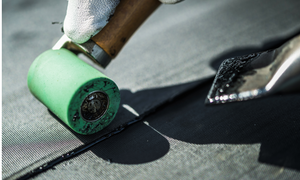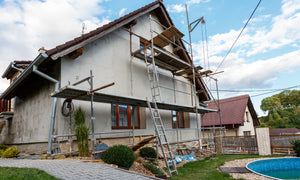4 Finishing and Repairing Methods For Your Plastic Signs and Banners

There are a variety of plastic welding methods that can be used for your sign and banner finishing and repair operations.
So how do you choose the right one for your application?
Choosing between hot air, chemical, high frequency, and hot wedge welding can be a challenge, especially when factoring in the type of welded seam and material.
Typical welded seams for sign and banner applications include overlap welds, hem welds, pocket welds, keder (piping) welds, and reinforced thermoplastic tape welds.
Plus, it’s key to determine the weight and type of thermoplastic materials. Depending on the type of job, technicians typically use 10-ounce, 13-ounce, 15-ounce, or 18-ounce thermoplastic materials. These include webbing, reinforced (scrim) coated fabrics, and mesh (woven) sheets, or membranes. Reinforced membranes are manufactured with an internal material (heavy fabric), which provides higher tensile strength and durability. For some applications, thicker, non-reinforced membranes, such as block-out materials, may also be used for double-sided printed signage and banners.
When completed, welded finished and repaired seams have an outstanding appearance. They are also waterproof, flexible, and strong. In many cases, the tensile strength of the welded seam is stronger than the material itself.
To help you decide which finishing and repairing method is right for you and reap these benefits, we dive into several options below.
1. Hot Air Welding
The main welding parameters for hot air welding are temperature, welding speed, and pressure. Hot air welding, also known as hot gas welding, is a widely used method for welding sign and banner thermoplastic materials. The tools to perform this operation include portable automatic welding machines and hot air handheld welding tools.
Portable Automatic Welding Machines
Automatic (robotic) welding machines are portable and lightweight for benchtop or field use and can be easily stored when not in use. They are designed with an adjustable temperature setting and variable speed control, as well as a weighted pressure wheel system. These features allow the technician to easily set up the machine to weld a variety of thermoplastic materials with varying sheet thicknesses.
These machines are also equipped with interchangeable flat wide slot airflow nozzles, which can be adjusted to evenly distribute the heated airflow. When the wide slot nozzle is inserted between the layered sheets, the machine will begin to automatically travel along the outside edges of the layered sheet, which melts the thermoplastic sheets. The built-in weighted pressure wheel rolls over and applies pressure to the plasticized sheet layers, which creates a welded seam. Once the welded surfaces have cooled, a molecular bond is formed, and the weld is complete.
Hot Air Handheld Welding Tools
These are lightweight tools that are designed with variable temperature and airflow settings. Like the portable automatic welding machines, hot air tools are also used with interchangeable flat wide slot nozzles.
Once the tool reaches the desired temperature and airflow settings, the technician will insert the wide slot nozzle between the two thermoplastic sheets or membranes being welded. Holding the hot air tool in one hand and a specially designed roller in the other, the technician will heat both layers of material while moving the hot air tool along the outside edges of the membranes. As the layered sheets begin to melt, both heated membranes are pressed together with downward pressure applied to the handheld roller. The technician moves the roller in quick back-and-forth movements, which creates a welded seam. Once the welded surfaces have cooled, a molecular bond is formed, and the weld is complete.
2. Chemical Welding
Chemical, or solvent, is achieved by liquifying the layered materials. The chemical solvent is evenly applied along the outside edges of the layered sheets with a brush or dauber. As the solvent is applied, it begins to soften the layered sheets and they become fluid. The technician will then apply pressure to the layered surfaces by pressing them together. A chemical bond is achieved when the solvent begins to evaporate, and a molecular bond is created. The bond is complete once the solvent has completely evaporated.
It is important to remember that there are some precautionary safety measures that should be followed when using chemical solvents. Some solvents can irritate the skin and should be used with proper protection, including gloves and a smock. Also, as solvents evaporate, their vapors can be hazardous if inhaled or exposed to flammable objects. Because of this, they should be used in a well-ventilated area. Precautions should also be taken to avoid contact with sources of heat, sparks, and other possible causes of ignition. Be sure to consult the manufacturer usage guidelines and recommendations.
3. High-Frequency Welding
High-frequency welding, also known as radio frequency welding (dielectric welding), is a process of welding thermoplastic materials together by applying radio frequency energy to the area to be joined. The heating process occurs when an electromagnetic field is generated, which is created using a typical frequency range of 50 to 100MHz. The heated energy is then transferred through a set of adjustable bars or dies. These bars or dies are mounted on an adjustable assembly, which is designed to accurately align with the area to be welded. Once the heat output reaches the desired temperature setting, the heat energy is transferred into the thermoplastic sheet layers, melting them, and forming a molecular bond.
4. Hot Wedge Welding
Hot wedge welding, also known as hot wedge rotary heat sealing, uses a heated metal wedge to weld multiple layers of thermoplastic material. Using heat, speed, and pressure settings, the machine is designed with variable speed pinch rollers, which apply pressure to the layered sheets while pulling them across the heated wedge. The hot wedge is precisely adjusted and placed between the pinch rollers. The layered sheets are inserted into the pinch rollers and heated by the metal wedge. The pinch rollers apply pressure to the layered materials, which have been softened and plasticized. A molecular bond is then achieved, and a welded seam is formed.
Is Plastic Welding Your Most Efficient Option?
If you are using banner tape, adhesive, or sewing methods, then the answer is yes.
Banner tape or adhesives are commonly used where quick turnaround times are required. However, both methods can be more time-consuming than the plastic welding methods. The added cost of materials such as tape, adhesives, and other supplies, as well as labor, can also have a significant impact on profit margins. Over time, these expenses can outweigh the initial cost of updating to a plastic welding method.
Sewing is another method that is commonly used in finishing and repair applications. Some signage and banner manufacturers outsource their sewing production jobs. Although this operation can be done in-house, the potential problems associated with the sewing method can be costly and have a significant impact on profit margins. These include thread breakage, thread jams, and material puckering, which can also lead to disruptions in production and result in significant downtime. In addition, like banner tape and the use of adhesives, sewing has the added cost of labor and materials such as thread, needles, cleaning and oiling, and mechanical adjustments. Over time, these factors can also outweigh the initial cost of updating to a plastic welding method.
For these reasons, the plastic welding method is the easiest, fastest, and most cost-effective option for sign and banner finishing and repair operations.
Need Help Choosing Your Sign and Banner Welding Tool?
If plastic welding is your preferred method for sign and banner finishing and repairing, then you’ve come to the right place. With hundreds of sign and banner hot air tools and accessories, you can find everything you need in one place. Contact us if you’d like to learn more or want to take a deeper dive into our product selection.
- Robert Heater







